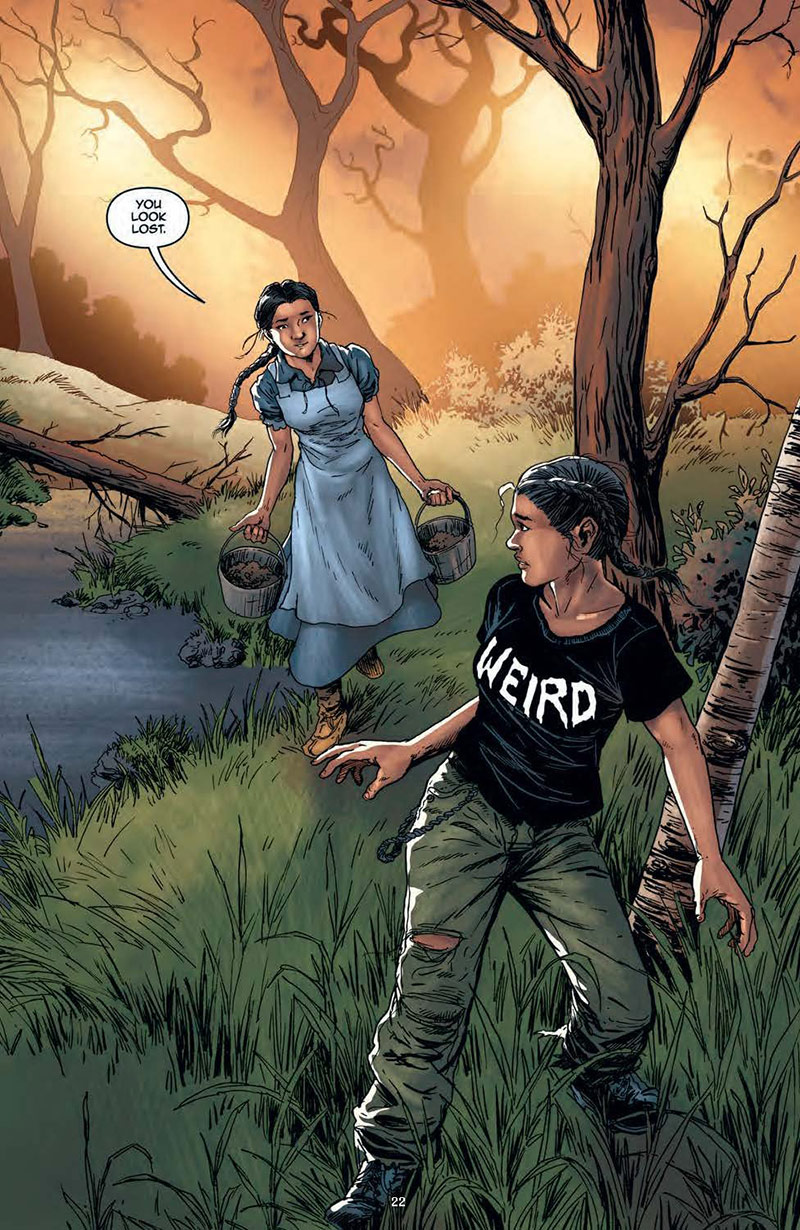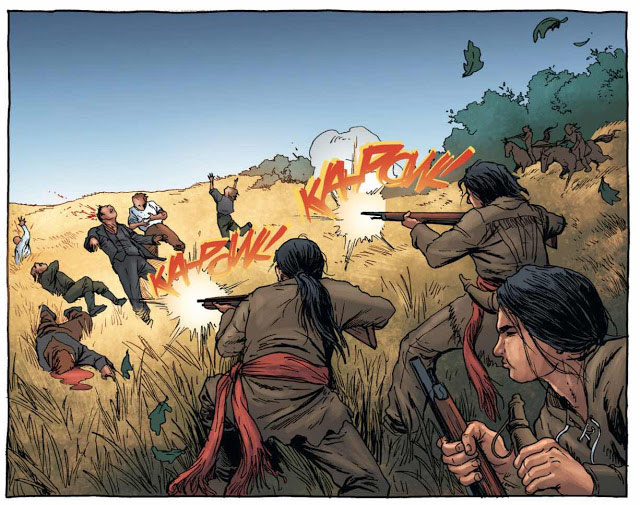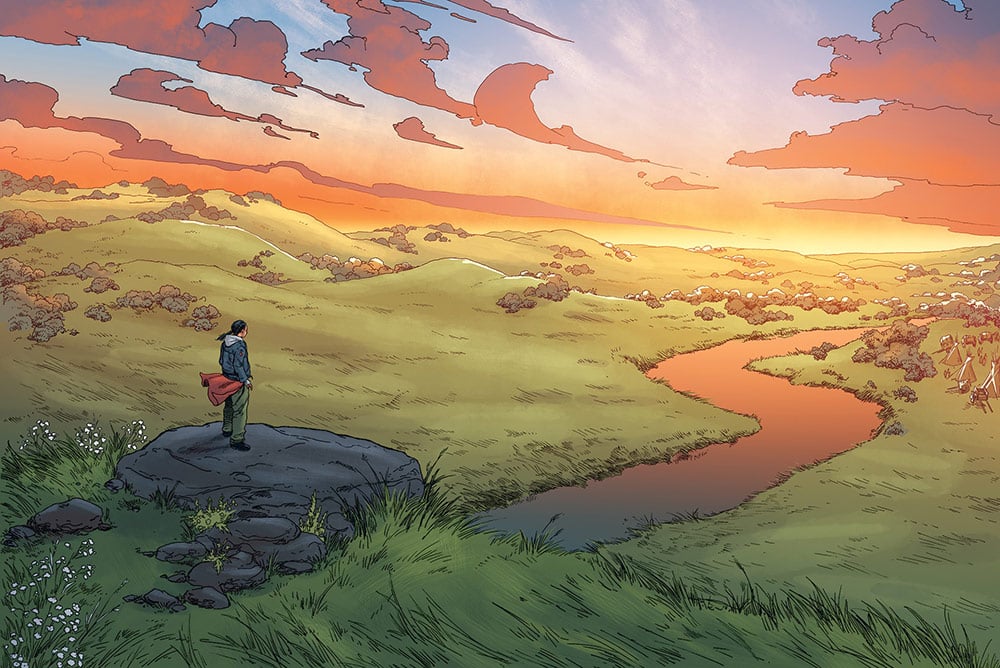- A Girl Called Echo, Vol. 1-4: Pemmican Wars, Red River Resistance, Northwest Resistance and Road Allowance Era
- Highwater Press (2021)
Katherena Vermette introduces the reader to Echo Desjardins in her first of four A Girl Called Echo graphic novels: Pemmican Wars.
Echo is a 13-year-old Métis girl who finds herself in a new school, living with a new family in foster care while her mother is receiving care at some form of live-in rehabilitation service in Winnipeg.
It is evident that Echo feels disconnected, alone and lost as she navigates her new situation and surroundings away from her mother. Although it appears that Echo has not unpacked any of her belongings into her new home, she comforts herself by listening to songs on her phone that remind her of her mother. The playlist, “Mom’s Old CDs,” is used to shut out everything in Echo’s world and works as a vice to cope with her new circumstances. The music continues to keep her connected to her relationship with her mother and to her past.
The music, paired with the lessons about Métis history in Mr. Bee’s history class, has the ability to make Echo fall asleep — and sends her back to 1814, to the Métis Bison Hunt and early Pemmican Wars on the Prairies. At first she is merely an observer, but then finds herself submersed in Métis culture and family during her time in the distant past.
She begins to interact with a young girl named Marie. It is easy to see that she is substituting the connections that she is making with the characters from the past with the disconnection that she is having with her mother. Through her visits to the past, it is evident that she is not just becoming more interested in Métis history and her own identity, but also feels a personal connection to the events that are unfolding.

This and the subsequent three books in Vermette’s series provide a basic historical journey through some of the main events that occurred in Western Canada, and promises to provide a good introduction to the strength, determination and resistance of the Métis Nation over the 19th century.
But these books also, more importantly, shine light into one of the many experiences of a contemporary Métis family. This series is relatable for many young readers faced with the same situations of fitting in, popularity, connection and finding their place in the world. These volumes draw out the realities of many Métis who find their way home by finding strength and pride in their histories.
These books also strive for inclusivity, as evidenced in the imagery of pride flags, non-binary characters, people with disabilities and Indigenous recognition.
The second book of the series, Red River Resistance, takes up where the previous graphic novel left off. But this book seems to open with a brighter tone. Echo awakens in her unpacked room after dreaming about buffalo. This is the first time that the reader sees Echo smile. In this volume of the series, Echo spends much of the time transported into 1869 through her mother’s music to observe the lead up to the activities of Louis Riel and the Red River Resistance in modern-day Manitoba. She continues to have strengthening interactive relationships with the Métis people in the past, and these relationships seem to have an effect on her contemporary life with her own personal relationships at the foster home and at school.

Echo now seems to feel more at ease in her new situation — playing with the other children in the foster home and meeting a new friend at school named Micah. Echo spends most of her time in the past with a prominent character named Benjamin. This character acts not only as a narrator for the events that Echo is involved in, but also provides Echo with care and support. In the end, Echo learns that the Métis end up losing their lands to the Dominion of Canada, and many end up moving on to Batoche or Willow Bunch both to follow the buffalo and to keep a distance from the new settlers. This is a sad time for Echo as she mourns the experiences of Métis during this time.
In Vermette’s third volume, Northwest Resistance, Echo’s mother is released from her care facility. Echo is nervous that her mother will not continue living in a healthy way, but she is happy that she has been released. Almost immediately, Echo falls asleep on the couch and is catapulted back to 1885 where she meets another prominent woman named Josephine, whom she later learns is Benjamin’s daughter. This graphic novel packs a punch of resistance and defiance as Josephine shows her determination to fight for the rights of Métis people who have fought on the land. She projects that without any land, the Métis are lost.
“You cannot exist without having that spot of land,” Louis Riel claims. “This is the principle. God cannot create a tribe without locating it. We are not birds.”
To lose the relationships to the land on the Prairies would mean losing important Métis history and culture. Echo admires Josephine’s passion but is skeptical of any wars since witnessing what had happened at the Red River over 15 years prior. Regardless, another resistance ensues, and many people are killed at Duck Lake. Louis Riel turns himself in. The Métis again lose their "place" without treaty and without land. This is troubling to Echo as she feels as though she has become a part of this history. Back in contemporary time, Echo’s mother has also become invested in revisiting her genealogy and collects photos and historical documents to show to Echo. These documents begin to put together a very familiar looking family tree.

In Vermette’s final volume of the A Girl Called Echo series, Road Allowance, Echo learns that she no longer needs to fall asleep or to listen to her mother’s music to return to the past and to connect with the Métis people she has met. She merely states that she wants to return to see Josephine, and is taken back to 1885. It is here where she learns of Riel’s trial and execution, and the hanging of other leaders who were defending their rights, such as Chief Big Bear and Chief Poundmaker. She realizes the fact that at that time, there is nowhere else for the Métis to turn, and many return to Manitoba to attain scrip for land that was never fulfilled.
Echo is devastated that the Métis were left poor and homeless and living on Crown land as squatters. She reconnects with Benjamin in the Métis-built community of Ste. Madeleine and asks him how and why this has been happening to the Métis. Benjamin articulately states that the experiences of Métis from the past continue to inform the Métis in the future through blood memory. Benjamin states, “all we have is in you… all our strength too.” Echo had always wanted to be anywhere but where she was, and she went back into the past to escape from her own misery. In doing so, she better understood herself and her importance. Métis continue to survive because Echo survives in the future.
Throughout all four A Girl Called Echo graphic novels, Vermette inserts musical references that, too, tell a story. As someone who enjoys music I knew the lyrics to most of the songs, which pleasurably added to the depth of the experience. I would encourage the reader to download these songs to gain a different perspective of Echo’s sorrow, anger, love and resistance through music. The irony of “Been Caught Stealing” by Jane’s Addiction being selected on Echo’s mother’s playlist just prior to when the Red River Resistance opens, cannot be ignored.
This article, slightly edited, is reprinted from the excellent, B.C.-based Ormsby Review. ![]()
Read more: Indigenous, Art, Media
















Tyee Commenting Guidelines
Comments that violate guidelines risk being deleted, and violations may result in a temporary or permanent user ban. Maintain the spirit of good conversation to stay in the discussion.
*Please note The Tyee is not a forum for spreading misinformation about COVID-19, denying its existence or minimizing its risk to public health.
Do:
Do not: